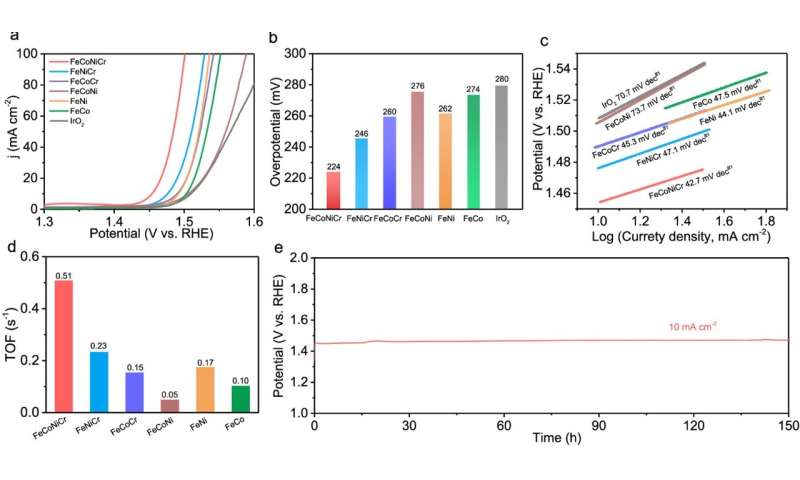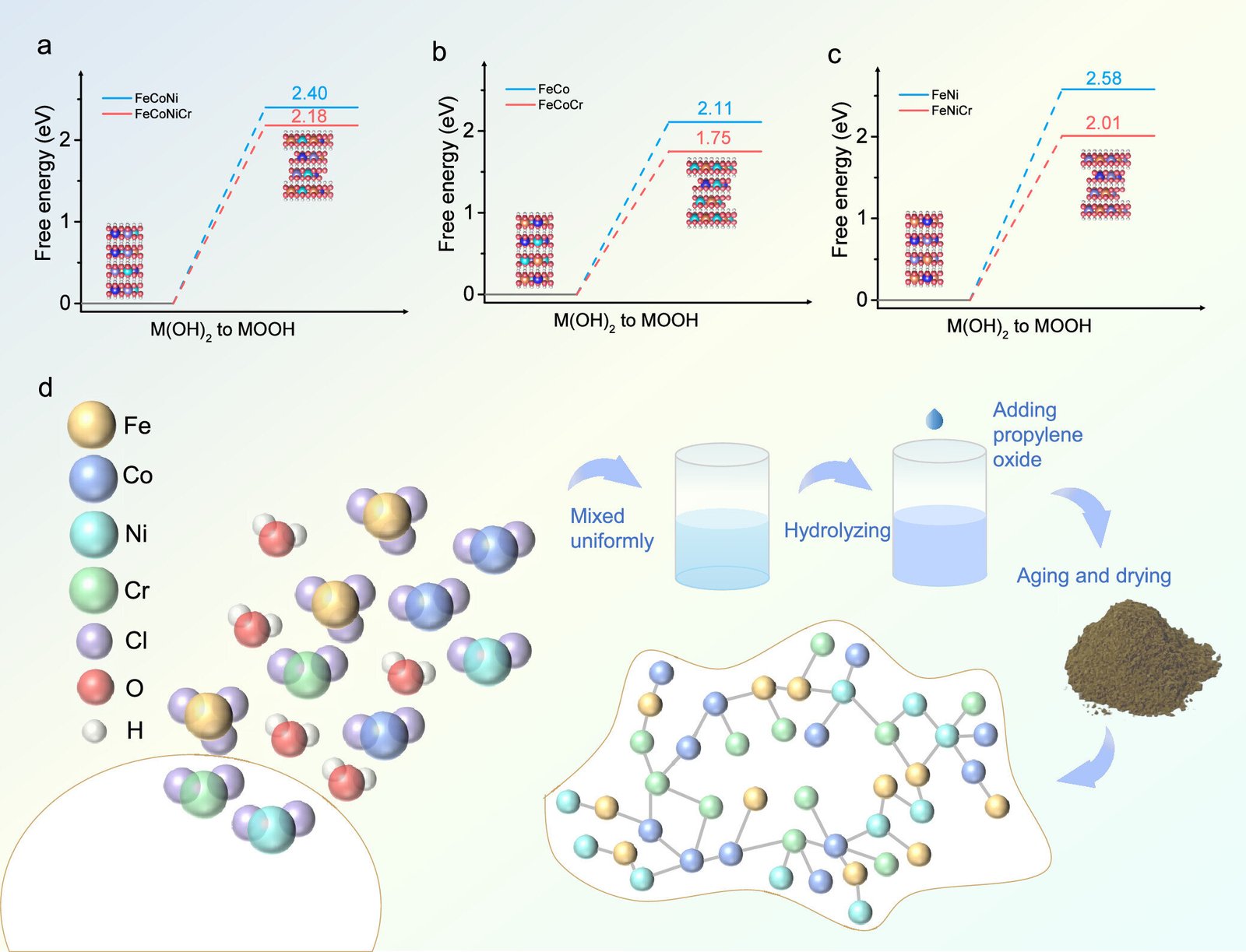
A group of researchers has made significant progress in developing cost-effective catalysts for the oxygen evolution reaction (OER), a critical component in technologies such as water splitting and metal-air batteries.
By incorporating chromium (Cr) into transition metal hydroxides, they have demonstrated enhanced catalytic activity using a combination of density functional theory (DFT) calculations and experimental synthesis. Their findings were published in the journal ACS Catalysis on August 30, 2024.
In recent years, hydrogen production through water electrolysis has emerged as a promising solution for storing intermittent renewable energy from sources like wind and solar. However, the OER, a key half-reaction in electrolysis, has been hindered by slow reaction rates, requiring high-activity and stable catalysts to improve efficiency.
“Chromium doping plays a crucial role in accelerating the phase transition of metal hydroxides into the active oxyhydroxide phase, which is essential for boosting OER efficiency,” said Hao Li, from Tohoku University’s Advanced Institute for Materials Research (WPI-AIMR) and co-author of the paper.
Li and his colleagues synthesized a FeCoNiCr hydroxide catalyst using an aqueous sol-gel method, ensuring a uniform distribution of the four elements. The prepared catalyst showed a low overpotential of 224 mV in alkaline media, outperforming similar catalysts by 52 mV, and maintained stability for over 150 hours of continuous use.
-

Electrocatalysis OER of FeCoNiCr hydroxide in 1 M KOH. (a) iR-corrected LSV curves of FeCoNiCr, FeNiCr, FeCoCr, FeCoNi, FeNi, FeCo catalysts in 1 M KOH. (b) Overpotentials required for j=10 mA cm−2 of different catalysts. (c) Tafel plots of different catalysts. (d) TOFs calculated at 1.58 V assuming all metal sites were involved in OER of different catalysts. (e) Potentiostatic curve of FeCoNiCr at a current density of 10 mA cm-2. Credit: ACS Catalysis (2024). DOI: 10.1021/acscatal.4c03974
-

DFT calculations of FeCoNiCr oxyhydroxide. Calculated 1D (a) and 2D (b) surface Pourbaix diagrams for the FeCoNiCr oxyhydroxide ( ) surface as a function of potential (T = 298.15 K). (c) Optimized adsorption structures for HO* and O* (top view) on FeCoNiCr and FeCoNi pre-covered by hydroxyls. (d) Microkinetic OER volcano at the current density of 1 mA cm−2, with the points indicating the OER potentials of Fe, Co, Ni, Cr sites on FeCoNiCr and Fe, Co, Ni sites on FeCoNi. The Bader charges on the active Ni (e) and Co (f) sites on FeCoNiCr during OER. Credit: ACS Catalysis (2024). DOI: 10.1021/acscatal.4c03974
In addition, a Zn-air battery assembled with the FeCoNiCr catalyst operated stably for 160 hours, maintaining a low discharge/charge voltage difference of 0.70 V. Theoretical models confirmed that Cr doping optimized the adsorption energies of OER intermediates at the active sites, significantly enhancing the reaction’s efficiency.
“Our calculations show that Cr doping fine-tunes the electronic environment around the active sites, making the reaction more efficient,” adds Li. Bader charge analysis further indicated that nickel and cobalt maintained a favorable +3 oxidation state during the OER process, which is beneficial for sustained catalytic activity.
Looking ahead, the group plans to expand their research by exploring other elements that could further optimize catalyst performance. “This work has provided us with a methodology for quickly screening materials and designing better catalysts,” said Di Zhang, a specially appointed assistant professor at WPI-AIMR and co-author of the paper.
“Our goal is to create even more efficient and durable catalysts that can accelerate the adoption of clean energy technologies, especially hydrogen production.”
As global demand for clean energy solutions grows, the development of cost-effective and efficient catalysts will be pivotal in advancing renewable energy systems.
More information:
Yong Wang et al, Chromium Promotes Phase Transformation to Active Oxyhydroxide for Efficient Oxygen Evolution, ACS Catalysis (2024). DOI: 10.1021/acscatal.4c03974
Provided by
Tohoku University
Citation:
Chromium doping enhances catalyst performance for faster oxygen evolution (2024, September 11)
retrieved 11 September 2024
from https://phys.org/news/2024-09-chromium-doping-catalyst-faster-oxygen.html
This document is subject to copyright. Apart from any fair dealing for the purpose of private study or research, no
part may be reproduced without the written permission. The content is provided for information purposes only.
